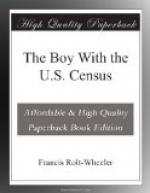“On that basis,” said Hamilton, “if the second most important language of Denmark is German a card that was punched ‘Den’ for the country would have to be punched ‘OL’ if the person whose census was registered had spoken German as his native tongue, but ‘LC’ if he had spoken Danish, which is the native tongue of the country. But I should think there would be some cases that would not come under that rule.”
“There are—a few,” the foreman replied, “but the way in which those are to be punched will be noted on the schedule by the schedule editors.”
“Some schedules need a good deal of editing, I suppose,” exclaimed Hamilton thoughtfully.
“You may be sure of that,” the other answered. “If you think for a moment how impossible it would be to have all the supervisors and enumerators work exactly in the same style, you can see how necessary it must be for some group of persons to go over them to make them all uniform. Besides which, there are a lot of obvious mistakes that the editors remedy before the card is punched ready for tabulation. But go on with your explanation, so that I can see if you really do understand it.”
“The parent columns run the same way, of course,” Hamilton continued, “‘U.S.’ meaning any one born in the United States, and ‘Un.’ cases in which the parentage is unknown. Then ‘NP’ means native-born parents, and ‘FP’ foreign-born parents. Further on, ‘Na’ means Naturalized, ‘Al’ stands for Alien, ‘Pa’ that first papers have been taken out, and ‘Un’ unknown. Down the column, ‘En’ seems to mean that the foreign-born can speak English, ‘Ot’ that he can only speak some tongue other than English. The year of immigration, of course, is obvious. But this occupation, I can’t make head or tail of!”
“That you have to learn,” the instructor said. “There is a printed list here for reference that contains the principal kinds of employment in the United States and classifies them. In a very little while you will find that you can remember the numbers which signify the more common of these and you will need to refer to the list but seldom. All occupation returns not contained in the printed list will be classified and punched later by a special force of clerks. Holes punched for those out of work and the number of weeks unemployed are all easy. At the top of the last column, too, ‘Emp’ means Employer, ‘W’ Wage Earner, while ‘OA’ means working on his or her own account, and ‘Un’ is for Unemployed.”
“All right, sir,” Hamilton replied, “I think I can do it now. I should find it harder, though, if I hadn’t been writing all those things just exactly as they are here on population schedules for the last month.”
“It makes an astonishing difference,” the experienced man agreed, “you know the why and wherefore of everything. Now you had better take this old test schedule and I will give you fifty blank cards, and we will see how they come out.”




